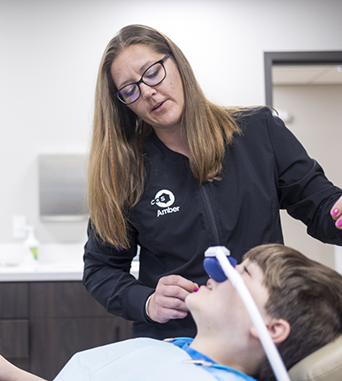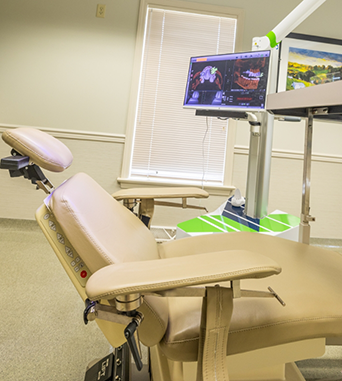Anesthesia Services Lancaster
Easing You Into Comfort & Helping You Relax

Providing IV sedation and local anesthesia to our patients at Conestoga Oral Surgery is at the core of what we do. We take great pride in our ability to ensure both safety and comfort during your or your loved one’s surgical procedure. Training in anesthesia for an Oral & Maxillofacial Surgeon consists of a minimum of 5 months in a hospital anesthesiology service. This focused, in-depth training consists of providing both general and regional anesthesia, managing difficult airways, using advanced patient monitoring techniques, and administering life-saving therapies. In addition, hundreds of hours of outpatient anesthesia services encompass the breadth of our training. If you have questions about our anesthesia services in Lancaster, we encourage you to call our office to schedule a consultation with one of our doctors.
Why Choose Conestoga Oral Surgery for Anesthesia Services?
- Entire Dental Assistant Team is DAANCE-Certified To Provide an Extra Level of Safety For Our Patients
- All Doctors are BLS, ACLS & PALS Certified
- Anesthesiologist/CRNA Works In-house for Complex and Lengthy Surgical Procedures
Unparalleled Experience & Comfort

All of the surgeons at Conestoga Oral Surgery are accredited in Basic Life Support (BLS), Advanced Cardiac Life Support (ACLS) and Pediatric Advanced Life Support (PALS) as well as board certified by the American Board of Oral and Maxillofacial Surgery. All of our surgical assistants are also Basic Life Support (BLS) certified and are required to pass the Dental Anesthesia Assistant National Certification Exam (DAANCE) within their first year working at Conestoga Oral Surgery. This exam requires in-depth training to allow the staff to provide proficient supportive anesthesia care in a safe and effective manner with our doctors.
To ensure we maintain the highest standards of in-office anesthesia, including proper facility layouts, crash cart setup, and up-to-date knowledge, we have independent third-party site evaluations annually. For your convenience for larger operative cases, we also have a fully equipped operating room at our Lancaster oral surgery office that is staffed with an Anesthesiologist/CRNA for your safety during surgery.
Here are the sedation options available:
Oral Conscious Sedation

Oral conscious sedation is administered in the form of a pill that our oral surgeons will prescribe for you to take before your appointment. The medication is typically Diazepam and will help ease any anxiety or fear you may feel about coming in for your procedure. The effects can linger for up to eight hours, so be prepared to have a trusted friend or family member transport you to and from our practice, and make sure all paperwork and consent forms are completed PRIOR to your surgery.
Nitrous Oxide Sedation

Nitrous oxide is ideal for patients who are receiving less invasive, shorter procedures and struggle with dental anxiety. In many cases, if you receive nitrous oxide in-office, you’ll be able to return to your daily routine immediately following your visit, as the effects don’t linger. When you arrive, our team will place a small mask over your nose to allow you to breathe in nitrous oxide. The effects will set in within minutes, making you feel euphoric and relaxed. After your procedure, you will breathe 100% oxygen before removing the mask.
IV Sedation

IV sedation is typically recommended for our patients who are undergoing a shorter procedure such as wisdom teeth extraction or for those who experience heightened anxiety. education is administered directly into an IV catheter, having a more potent and fast-acting effect. Throughout your procedure, our DAANCE-certified team will assist your thoroughly trained surgeon in your care.
General Anesthesia

Our fully equipped, state-of-art operating room at our Lancaster location is staffed with an Anesthesiologist/CRNA to offer general anesthesia. This service is usually used for more complex or longer procedures that require a protected airway. This allows for increased patient safety and additonal monitoring.
Before Intravenous Anesthesia Sedation

- You may not have anything to eat or drink (including water) for eight (8) hours prior to your appointment.
- No smoking for at least 12 hours before surgery. Ideally, cutting back or completely stopping smoking as soon as possible prior to the day of surgery.
- A responsible adult must accompany the patient to the office, remain in the office during the procedure, and drive the patient home.
- The patient should not drive a vehicle or operate any machinery for 24 hours following the anesthesia administration.
- Please wear loose fitting clothing with sleeves which can be rolled up past the elbow. NO FLIP FLOPS!
- Contact lenses, jewelry, and dentures must be removed at the time of surgery.
- Do not wear lipstick, excessive makeup, or nail polish on the day of surgery.
- If you have an illness such as a cold, sore throat, or bowel upset, please notify the office as soon as possible as the sedation procedure may need to be delayed for several weeks.
- Take all of your routine morning medications with a sip of water, unless directed otherwise by your surgeon.
- Notify your doctor at the consultation if you are taking Ozempic, Trulicity, Byetta, Victoza, Rybelsus, or Adlyxin, as these medications may need to be held.
